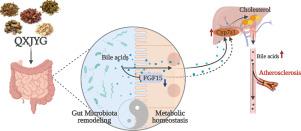Phytomedicine ( IF 7.9 ) Pub Date : 2022-06-01 , DOI: 10.1016/j.phymed.2022.154220 Anlu Wang 1 , Baoyi Guan 1 , Chang Shao 2 , Lin Zhao 1 , Qiuyi Li 1 , Haiping Hao 2 , Zhuye Gao 1 , Keji Chen 1 , Yuanlong Hou 2 , Hao Xu 1

|
Background
Atherosclerosis (AS) is a key pathological factor in cardiovascular disease (CVD) and is characterized by high mortality and morbidity worldwide. Metabolic disorders, including pathoglycemia and dyslipidemia that lead to chronic inflammation, represent the prominent pathological characteristics of atherosclerotic CVD, Qing-Xin-Jie-Yu Granule (QXJYG) is a Chinese traditional decoction that has been clinically proven to be effective for patients with CVD. However, the underlying mechanisms have not been completely elucidated.
Purpose
To investigate the protective effects of QXJYG against AS and its potential mechanisms.
Methods
QXJYG was orally administered at doses of 1.664 and 4.992 g·kg-1·d-1 in a high-fat diet (HFD)-induced AS model using ApoE-/- mice. Histopathological and immunohistochemical analyses, ELISA, untargeted and targeted metabolomics analysis, 16S rRNA analysis, and RT-qPCR were performed to identify the therapeutic effects and mechanisms of QXJYG in treating HFD-induced AS.
Results
QXJYG retarded HFD-induced weight gain and reduced the increased serum levels of total cholesterol, triglycerides, and low-density lipoprotein-cholesterol, whereas high-dose QXJYG increased the serum level of high-density lipoprotein-cholesterol in HFD-fed ApoE-/- mice. Meanwhile, QXJYG reduced the serum levels, as well as aortas mRNA levels of the inflammatory cytokines, IL-1β and IL-6, which indicates that QXJYG is effective against metaflammation. Mechanistically, QXJYG reshaped the gut microbiota and its associated bile acids (BAs) metabolomic phenotype, partly by increasing the levels of BA synthesis enzymes, hepatic CYP7A1, and CYP27A1, while decreasing ileal FGF15 and β-Klotho mRNA expression, favoring facilitated de novo BAs synthesis and thereby driving cholesterol catabolic excretion.
Conclusion
Our findings indicate that QXJYG is effective against HFD-triggered chronic inflammation, and contributes to the alleviation of AS development, and the antiatherogenic properties of QXJYG may be partly due to the remodeling of the gut microbiota and BA metabolism. Although the results are encouraging, further clinical studies of anti-AS herbal medicines are required to elucidate the full potential of the gut microbiota and BA metabolism.


























 京公网安备 11010802027423号
京公网安备 11010802027423号